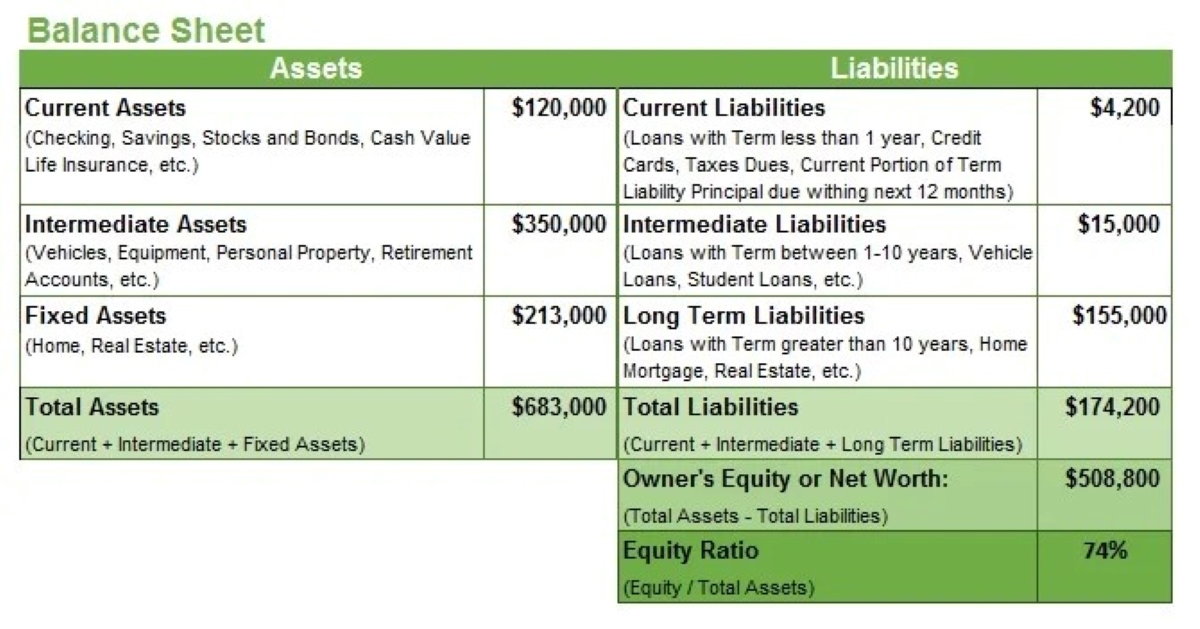Home>Finance>What Are The Effects Of A Large Amount Of Debt In Capital Structure


Finance
What Are The Effects Of A Large Amount Of Debt In Capital Structure
Modified: February 21, 2024
Learn the financial implications of having a significant amount of debt in your capital structure and how it can impact your overall financial health. Gain insights into the effects of debt on your finance.
(Many of the links in this article redirect to a specific reviewed product. Your purchase of these products through affiliate links helps to generate commission for LiveWell, at no extra cost. Learn more)
Table of Contents
- Introduction
- Definition of Capital Structure
- Importance of Debt in Capital Structure
- Effects of a Large Amount of Debt in Capital Structure
- Financial Risk
- Decreased Profitability
- Reduced Financial Flexibility
- Impact on Credit Rating
- Increase in Interest Expense
- Effect on Shareholder Value
- Case Studies
- Conclusion
Introduction
Capital structure is a crucial aspect of a company’s financial framework, determining how it raises and allocates funds to support its operations and growth. It refers to the mix of debt and equity that a company utilizes to finance its activities and maintain its optimal financial balance. While equity represents the ownership stake of shareholders, debt represents borrowed money that the company must repay with interest over time.
The proportion of debt and equity in a company’s capital structure has significant implications for its overall financial health and stability. Debt can be an essential component of capital structure, allowing companies to access large amounts of capital and leverage their financial position to invest in growth opportunities. However, when a company carries a large amount of debt in its capital structure, it can have various effects on its financial well-being and performance.
In this article, we will explore the effects of a large amount of debt in a company’s capital structure. We will examine the potential risks, challenges, and considerations associated with higher levels of debt in a company’s financial structure. Additionally, we will highlight the impact of excessive debt on a company’s profitability, financial flexibility, credit ratings, interest expenses, and shareholder value.
By examining these effects, we aim to provide a comprehensive understanding of the consequences that a high debt burden can have on a company. This knowledge will allow investors, financial analysts, and business owners to make informed decisions regarding their capital structure and effectively manage potential risks associated with a large amount of debt.
Definition of Capital Structure
Capital structure refers to the way a company finances its operations and investments by utilizing a combination of debt and equity. It represents the composition of a company’s long-term sources of funds and determines how the company raises and deploys capital.
The two main components of capital structure are debt and equity. Debt represents borrowed funds that a company is obligated to repay over time, usually with interest. Equity, on the other hand, represents the ownership interest of shareholders in the company.
When determining the optimal capital structure, companies need to strike a balance between debt and equity sources. The composition of the capital structure can vary based on factors such as industry dynamics, business risk, growth prospects, and access to different sources of funding.
Debt can take various forms, including bank loans, corporate bonds, and other forms of borrowing. By utilizing debt, companies can access external funds that allow them to finance their operations and investments without diluting existing shareholders’ ownership. Additionally, debt often comes with tax advantages since interest payments are tax-deductible expenses.
Equity, on the other hand, represents the portion of a company’s financing that comes from issuing shares to investors. When a company issues equity, it dilutes existing shareholders’ ownership, as they now hold a smaller percentage of the company. However, equity financing provides companies with permanent capital that does not need to be repaid.
The blend of debt and equity in a company’s capital structure has important implications for various aspects of its operations and financial health. The choice of capital structure can impact the cost of capital, risk profile, financial flexibility, and profitability of the company.
It is essential for companies to carefully consider their capital structure decisions to align with their strategic objectives, risk tolerance, and financial capabilities. Poorly managed capital structure can lead to financial instability, hinder growth prospects, and impact the overall sustainability of the company.
Now that we have established the definition of capital structure, let us delve into the importance of debt within this structure and its effects when there is a substantial amount of debt present.
Importance of Debt in Capital Structure
Debt plays a crucial role in a company’s capital structure and brings several advantages that make it an important source of funding. Understanding the importance of debt can help businesses make informed decisions about their financing strategies.
One of the key benefits of debt is its ability to provide a company with access to a larger pool of capital than what could be obtained through equity alone. By borrowing funds, companies can finance their operations, invest in projects, expand their business, or acquire other companies. Debt allows companies to leverage their financial position and allocate resources more efficiently.
In addition to enabling companies to access a larger amount of capital, debt also comes with a fixed cost known as interest. This fixed interest obligation can be advantageous for companies, especially when the interest rates are lower than the expected return on the investments made using the borrowed funds. This leverage effect can amplify the company’s profitability and enhance shareholder value.
Debt can also facilitate tax benefits for companies. In many jurisdictions, interest payments on debt are tax-deductible expenses. This tax shield reduces the company’s tax liability and increases its after-tax cash flows. As a result, companies can effectively lower their overall cost of capital by incorporating debt in their capital structure.
Furthermore, debt financing allows companies to maintain greater control and ownership of their business. While equity financing involves selling ownership stakes in the company, debt financing does not dilute ownership. This means that company founders and existing shareholders can retain control over decision-making and strategic direction.
Debt financing can also be a useful tool for companies to signal their creditworthiness and financial stability. By successfully raising and managing debt, companies can demonstrate to investors, lenders, and other stakeholders that they have a disciplined approach to financial management. This can enhance the company’s reputation and access to future funding opportunities.
Overall, debt is a significant component of a company’s capital structure. It allows companies to access larger amounts of capital, benefit from tax advantages, maintain control over the business, and signal financial strength. However, it is important to acknowledge that excessive debt can have adverse effects on a company’s financial health, as we will explore in the next section.
Effects of a Large Amount of Debt in Capital Structure
While debt can provide numerous advantages to companies, having a large amount of debt in a company’s capital structure can also have significant consequences. It is essential for businesses to carefully manage their debt levels to avoid potential drawbacks that can impact their financial stability and long-term viability.
1. Financial Risk:
One of the primary effects of a large amount of debt is an increase in financial risk. When a company carries a substantial debt burden, it faces higher levels of interest expense and debt repayment obligations. This can strain its cash flow and financial flexibility, making it more vulnerable to economic downturns, interest rate hikes, or unexpected disruptions in the business environment. Consequently, the company’s overall financial risk profile increases, potentially leading to higher borrowing costs and limited access to additional funding.
2. Decreased Profitability:
The presence of significant debt can put pressure on a company’s profitability. As interest payments increase, a larger portion of the company’s earnings is earmarked for debt servicing, reducing the available funds for business growth, research and development, or dividend distributions to shareholders. Additionally, as debt levels rise, the company may face higher interest rates or more stringent lending terms, further eroding profitability. This can have a negative impact on the company’s ability to generate returns for investors and hinder its long-term sustainability.
3. Reduced Financial Flexibility:
A large amount of debt can limit a company’s financial flexibility. It may constrain the company’s ability to undertake new investments, respond to market changes, or seize growth opportunities. High debt levels may result in restrictions imposed by lenders, known as debt covenants, which impose limitations on the company’s financial activities, such as dividend payments, capital expenditures, or acquisitions. These restrictions can impede the company’s agility and hinder its ability to adapt to evolving market conditions.
4. Impact on Credit Rating:
A company with a substantial debt burden may face challenges in maintaining a favorable credit rating. Rating agencies assess a company’s ability to meet its debt obligations, and excessive debt can raise concerns about the company’s creditworthiness. A downgrade in the credit rating makes it more difficult and costly for the company to borrow in the future. It can also have broader implications, such as damaging the company’s reputation and investor confidence.
5. Increase in Interest Expense:
Having a large amount of debt often translates to a higher interest expense for the company. As interest rates rise or as the company’s creditworthiness deteriorates, lenders may demand higher interest rates to compensate for the increased risk. The higher interest expense can eat into the company’s earnings and cash flow, reducing the funds available for other essential activities. This can further strain the company’s financial position and limit its ability to invest in growth initiatives.
6. Effect on Shareholder Value:
Excessive debt in the capital structure can have a negative impact on shareholder value. The increased financial risk, reduced profitability, and constrained financial flexibility resulting from a large debt burden can all contribute to a decline in the company’s stock price or market valuation. Additionally, high debt levels may make the company less attractive to potential investors, limiting its ability to raise additional equity capital in the future.
In summary, while debt can be a valuable tool for financing, having a large amount of debt in a company’s capital structure can carry significant consequences. It is crucial for businesses to carefully manage their debt levels and strike a balance that allows them to benefit from debt financing while mitigating the risks associated with excessive leverage.
Financial Risk
One of the key effects of having a large amount of debt in a company’s capital structure is the increase in financial risk. This risk arises from the company’s obligation to make interest payments and repay the principal amount of the debt within a specified timeframe.
When a company carries a substantial debt burden, it becomes more susceptible to financial instability and challenges. Here are some of the main ways in which a large amount of debt can contribute to increased financial risk:
1. Cash Flow Strain:
A significant debt burden can put a strain on a company’s cash flow. As the company needs to make regular interest payments and principal repayments, it must allocate a portion of its earnings to meet these obligations. This reduces the cash available for operational expenses, investments, and other essential activities. If the company’s cash flow is insufficient to cover its debt obligations, it may face liquidity issues and be at risk of default, damaging its financial position and reputation.
2. Interest Rate Risk:
Another aspect of financial risk is the exposure to interest rate fluctuations. If a company has variable interest rate debt, an increase in interest rates can significantly impact its interest expense. As interest rates rise, the company’s interest payments increase, resulting in a higher overall cost of debt. This can strain the company’s profitability and cash flow, as more funds are required to service the debt. It is essential for companies to assess their sensitivity to interest rates and consider potential hedging strategies to mitigate this risk.
3. Economic Downturns:
In times of economic slowdown or recession, companies with a large amount of debt are particularly vulnerable. During these periods, demand for products and services may decline, reducing the company’s revenue and cash flow. Companies with high debt levels may struggle to generate sufficient cash flow to meet their debt obligations and face difficulties in refinancing or extending the maturities of their debt. This can lead to financial distress, potential bankruptcy, or forced asset sales to repay debt, further exacerbating the financial risk.
4. Limited Access to Additional Funding:
A company with a high level of debt may find it challenging to raise additional funding in the future. Lenders and investors may perceive the company as having a higher risk profile due to the high debt burden. As a result, the company may face difficulties in obtaining favorable loan terms or attracting new equity investors. Limited access to funding can restrict the company’s ability to invest in growth opportunities, make strategic acquisitions, or withstand unexpected financial challenges.
5. Reputational Risk:
A large amount of debt can also impact a company’s reputation and relationships with stakeholders. If a company is heavily indebted, it may be seen as more financially vulnerable, which can erode trust among suppliers, customers, and partners. Negative perceptions about the company’s financial health can have a domino effect, leading to increased scrutiny from credit agencies, higher borrowing costs, and a decline in investor confidence. This can further exacerbate the financial risk and make it more difficult for the company to navigate through challenging times.
To mitigate financial risk, companies should carefully assess their debt capacity, ensure sufficient cash flow to meet debt obligations, and maintain a healthy debt-to-equity ratio. It is crucial to balance the benefits of debt financing with the potential risks, taking into consideration the nature of the industry, the company’s profitability, and its ability to generate consistent cash flows. By proactively managing financial risk, companies can position themselves for long-term financial stability and success.
Decreased Profitability
Carrying a large amount of debt in a company’s capital structure can have a detrimental impact on its profitability. The high interest expense associated with servicing the debt, along with other related costs, can eat into the company’s earnings and reduce its overall profitability. Here are some key factors that contribute to decreased profitability when a company has a significant debt burden:
1. Increased Interest Expense:
When a company carries a large amount of debt, it must make regular interest payments to its lenders. The higher the debt level, the larger the interest expense becomes. This interest expense is deducted from the company’s earnings before tax, resulting in reduced profitability. With a significant portion of earnings allocated to interest payments, less money is available for reinvestment in the company’s operations, research and development, or distribution to shareholders.
2. Debt Service Costs:
In addition to interest expenses, the company may also incur other costs associated with servicing the debt. For example, there might be fees related to debt issuance, loan origination fees, or costs associated with complying with debt covenants. These expenses further diminish the company’s profitability and can create a burden on its financial resources.
3. Diverted Cash Flow:
A large amount of debt in the capital structure can divert cash flow away from other value-enhancing activities. Rather than being available for reinvestment or growth initiatives, a significant portion of cash flow is allocated towards debt repayment. This can limit the company’s ability to invest in research and development, expand into new markets, or make strategic acquisitions that could contribute to long-term profitability.
4. Reduced Financial Flexibility:
A high debt burden can restrict a company’s financial flexibility, which in turn can impact profitability. When the company is bound by debt covenants or commitments made to lenders, it may face limitations on capital expenditures, dividend payments, or other strategic decisions. These restrictions can hinder the company’s ability to respond swiftly to changing market conditions, seize opportunities, or innovate. As a result, the company’s competitiveness and profitability potential may be compromised.
5. Higher Financial Risk:
Carrying a large amount of debt increases the financial risk of the company, leading to higher borrowing costs. As the company’s risk profile escalates, lenders may demand higher interest rates or impose more stringent borrowing terms. The increased interest rates further intensify the impact on profitability. Additionally, a higher risk rating by credit agencies can limit the company’s access to affordable financing options, constraining its ability to manage debt effectively and maintain profitability.
6. Impact on Shareholder Returns:
With decreased profitability, shareholders may experience a decline in returns on their investment. As the company’s earnings are diminished due to higher interest expenses and other debt-related costs, the ability to distribute profits to shareholders through dividends or share buybacks may be impaired. This can impact the attractiveness of the company’s stock and diminish shareholder value.
It is crucial for companies to carefully manage their debt levels to preserve profitability. By striking a balance between debt and equity financing, considering the overall cost of debt, and structuring borrowing terms to align with the company’s cash flow generation, companies can mitigate the impact on profitability and ensure sustainable long-term financial success.
Reduced Financial Flexibility
Having a large amount of debt in a company’s capital structure can significantly reduce its financial flexibility. Financial flexibility refers to the ability of a company to respond quickly and effectively to changing market conditions, seize growth opportunities, and navigate through financial challenges. Here are some key reasons why a high debt burden can limit financial flexibility:
1. Debt Service Obligations:
When a company has a substantial amount of debt, a significant portion of its cash flow must be allocated towards debt service obligations, including interest payments and principal repayments. This reduces the company’s ability to utilize the cash for other purposes, such as expanding operations, investing in new projects, or pursuing strategic initiatives. The rigid debt repayment schedule leaves less room for flexibility in managing the company’s financial resources.
2. Constraints on Capital Expenditures:
High debt levels can impose constraints on a company’s capital expenditures. Lenders may include covenants in debt agreements that restrict the company’s ability to spend beyond a certain limit on capital investments. Such restrictions can limit the company’s ability to invest in essential growth initiatives, upgrade infrastructure, or acquire critical assets. This reduced flexibility in capital expenditures can hinder the company’s ability to adapt to market demands or capitalize on emerging opportunities.
3. Limited Strategic Options:
A large debt burden can constrain a company’s strategic options. For example, if the company wants to pursue a merger or acquisition, it may face difficulties in obtaining financing due to already high debt levels. The company may also be constrained in its ability to raise additional equity capital to fund growth initiatives or product development. Limited strategic options can stifle the company’s ability to execute its long-term growth plans and compete effectively in the market.
4. Restrictions on Dividend Payments:
When a company has a significant amount of debt, lenders may impose restrictions on dividend payments as part of the loan agreement. These restrictions, known as debt covenants, aim to protect the lenders’ interests and ensure that the company can meet its debt obligations. As a result, the company’s ability to distribute profits to shareholders in the form of dividends may be limited, reducing the financial flexibility for shareholders and impacting the company’s attractiveness to potential investors.
5. Difficulty in Raising Additional Funding:
A company with a high debt burden may encounter challenges when trying to raise additional funding. Lenders and investors may perceive high debt levels as a risk factor, making it more difficult for the company to secure affordable financing options. Limited access to additional funding can impede the company’s ability to seize growth opportunities, make necessary investments, or navigate through financial challenges. This lack of financial flexibility can hinder the company’s ability to respond effectively to market dynamics and potentially lead to missed opportunities.
6. Higher Risk Profile:
A high debt burden can increase the company’s risk profile, which can further limit financial flexibility. Credit rating agencies may revise their ratings downward in response to higher debt levels, signaling higher risk. This can result in higher interest rates on future borrowings or constrain the company’s ability to enter into favorable financial agreements. A higher risk profile can reduce the company’s access to affordable financing, restricting its financial flexibility.
To enhance financial flexibility, companies should carefully evaluate and manage their debt levels. Striking a balance between debt and equity financing, establishing prudent debt repayment schedules, and optimizing capital allocation can provide companies with the necessary flexibility to adapt to changing market conditions, seize growth opportunities, and navigate through financial challenges.
Impact on Credit Rating
A large amount of debt in a company’s capital structure can have a significant impact on its credit rating. The credit rating assigned to a company reflects its creditworthiness and determines the cost and availability of future borrowings. Here are some key factors that contribute to the impact of high debt levels on a company’s credit rating:
1. Increased Financial Risk:
Carrying a substantial amount of debt increases a company’s financial risk profile. High debt levels indicate a higher likelihood of default or the inability to meet debt obligations. Credit rating agencies assess a company’s ability to service its debt based on various financial ratios, such as the debt-to-equity ratio, interest coverage ratio, and cash flow position. Higher debt levels can result in a lower assessment of the company’s financial stability, leading to a downgrade in the credit rating.
2. Debt Service Capacity:
High debt levels can impact a company’s debt service capacity, which is a key consideration for credit rating agencies. Debt service capacity refers to the company’s ability to generate sufficient cash flow to cover its debt obligations. As the debt burden increases, a larger portion of the company’s earnings is allocated towards interest payments and principal repayments. If the company’s cash flow is insufficient to meet its debt service requirements, it may indicate a higher risk of default and result in a lower credit rating.
3. Debt Covenants:
Debt agreements often include covenants that stipulate certain financial and operating conditions that the company must meet. These covenants can include requirements related to debt-to-equity ratios, interest coverage ratios, and minimum cash flow levels. If the company’s debt levels are high, it may be at risk of breaching these covenants if its financial performance deteriorates. Breaching debt covenants can trigger negative consequences, including higher interest rates, penalties, or the acceleration of debt repayment. Such events can further impact the credit rating of the company.
4. Evaluating Future Borrowing Capacity:
High debt levels can influence a company’s borrowing capacity in the future. Lenders assess the company’s financial health and creditworthiness when considering new loan applications or refinancing existing debt. A company with a large debt burden may face challenges in securing additional funding or may need to accept less favorable loan terms. If lenders perceive the company as having a higher risk profile, it can restrict the company’s access to affordable financing, limiting its financial flexibility and potentially leading to a lower credit rating.
5. Market Perception and Investor Confidence:
The perception of investors and market participants plays a role in determining a company’s credit rating. High debt levels can signal a higher level of financial risk, potentially eroding investor confidence. Negative sentiment surrounding the company’s financial stability can impact its stock price, increase borrowing costs, and make it more challenging to attract new investors. This market perception can further impact the company’s credit rating as credit rating agencies consider the company’s reputation and market standing in their assessment.
6. Impact on Borrowing Costs:
Lower credit ratings resulting from high debt levels can lead to higher borrowing costs. As a company’s credit rating declines, lenders may demand higher interest rates to compensate for the increased risk. This can result in higher interest expenses, reducing the company’s profitability and cash flow. Increased borrowing costs can further strain the company’s financial position and hinder its ability to manage and service its debt effectively.
Companies must be conscious of the impact that a large amount of debt can have on their credit rating. Maintaining a reasonable debt load, monitoring debt service capacity, and adhering to debt covenants can help mitigate potential negative consequences on the credit rating. A strong credit rating enables companies to access favorable financing terms, attract investors, and maintain financial stability, ensuring their ability to thrive in the market.
Increase in Interest Expense
When a company carries a significant amount of debt in its capital structure, one of the key effects is an increase in interest expense. Interest expense refers to the cost the company incurs for borrowing funds, which is paid to lenders or bondholders in the form of interest payments. The higher the debt levels, the more interest the company must pay, resulting in increased financial obligations. Here are the key factors contributing to the increase in interest expense:
1. Higher Debt Balance:
The primary driver of increased interest expense is the higher debt balance. As a company accumulates more debt, it must borrow larger amounts to accommodate its financing needs. With a larger principal balance, the interest payment calculated as a percentage of the debt also increases. This leads to higher interest expense and can have a significant impact on the company’s profitability and cash flow.
2. Interest Rates:
The prevailing interest rates at the time of borrowing can impact the company’s interest expense. If interest rates rise after the debt is issued, the company may face higher interest costs when it needs to refinance or renew its existing debt. Changes in interest rates can be influenced by various factors, such as central bank policies, inflation rates, and market conditions. Companies that have a significant amount of debt may be more vulnerable to fluctuations in interest rates, which can further increase their interest expense.
3. Type of Debt Instruments:
The type of debt instruments used by the company can also influence its interest expense. Different debt instruments, such as bank loans, corporate bonds, or convertible debt, may carry varying interest rates and terms. For example, bonds with higher interest rates or loans with floating interest rates can lead to increased interest expense compared to instruments with lower rates. Companies must carefully assess the terms and costs associated with different debt instruments to manage the impact on their interest expense.
4. Creditworthiness:
A company’s creditworthiness plays a crucial role in determining the interest rates it receives on its debt. Credit rating agencies assess a company’s ability to meet its debt obligations, and higher debt levels can impact its creditworthiness. If a company’s credit rating deteriorates as a result of its high debt burden, lenders may mark up the interest rates to compensate for the perceived increase in risk. This leads to an increase in interest expense and can strain the company’s financial resources.
5. Debt Maturity:
The maturity date of the debt can also impact the company’s interest expense. Debt with longer maturities often carries higher interest rates compared to short-term debt. Companies with longer-term debt may face higher interest expense due to the extended period over which interest is calculated. Managing the maturity profile of the debt becomes crucial to optimize the interest expense and align it with the company’s cash flow projections.
6. Affecting Profitability and Cash Flow:
Increased interest expense can have a direct impact on a company’s profitability and cash flow. Higher interest payments reduce the company’s net income, which affects its bottom line and overall profitability. Additionally, increased interest expense reduces the company’s cash flow available for other purposes, such as operational expenses, investments, or dividend distributions. This can limit the company’s ability to fund growth initiatives or provide returns to shareholders.
It is important for companies to carefully manage their debt levels and associated interest expense. This includes monitoring and evaluating interest rate trends, negotiating favorable borrowing terms, and assessing the impact of potential interest rate changes on the company’s financial position. By effectively managing interest expense, companies can minimize the strain on profitability and cash flow, ensuring a healthier financial outlook.
Effect on Shareholder Value
Carrying a large amount of debt in a company’s capital structure can have a significant impact on shareholder value. The accumulation of debt affects the company’s financial health and stability, which directly influences the perceptions and expectations of investors. Here are the key factors that contribute to the effect of high debt levels on shareholder value:
1. Dilution of Ownership:
When a company takes on debt, it typically does not dilute the ownership stake of existing shareholders. Unlike equity financing, where new shares are issued, debt financing allows the company to borrow funds without relinquishing ownership. This can be perceived as a positive for shareholders as their ownership remains intact.
2. Reduced Earnings Per Share:
High levels of debt can lead to increased interest expenses and debt servicing costs, which can reduce a company’s earnings. As interest expense eats into the company’s profits, the earnings available to shareholders decrease. This reduction in earnings per share can negatively impact shareholder value as investors assess the company’s financial performance and future potential.
3. Stock Price Volatility:
A company with a substantial debt burden can be more susceptible to stock price volatility. Negative news or changes in market conditions can trigger concerns among investors about the company’s ability to meet its debt obligations. This can lead to increased selling pressure and downward pressure on the stock price. Higher volatility can erode shareholder confidence and reduce the perceived value of their investment.
4. Impact on Dividends:
The presence of high debt levels can influence a company’s ability to pay dividends to shareholders. If the company needs to allocate a significant portion of its cash flow toward servicing its debt, it may have limited funds available for distributing dividends. This can result in lower dividend payments or a complete suspension of dividends, which can disappoint income-oriented investors and have a negative impact on shareholder value.
5. Investor Perception and Risk Assessment:
Investors closely monitor a company’s debt levels as a measure of financial health and risk assessment. High levels of debt can be perceived as a negative signal, indicating potential financial instability and increased risk. This perception can lead to lowered investor confidence and a decrease in the demand for the company’s shares, ultimately affecting shareholder value. Additionally, a higher debt burden can result in a lowered credit rating, which further influences investor perception and the company’s cost of capital.
6. Restrictive Financial Policies:
Companies with significant debt may implement more conservative financial policies to manage their debt burden. This can include measures such as reduced capital expenditure, cost-cutting initiatives, or limited investment in growth opportunities. While these policies may be necessary to ensure debt servicing, they can hinder the company’s growth potential and long-term value creation, impacting shareholder value.
It is crucial for companies to manage their debt levels prudently to protect and enhance shareholder value. This can be achieved through careful debt management, maintaining a healthy debt-to-equity ratio, and developing strategies to reduce debt over time. By managing debt effectively and striking a balance between debt and equity financing, companies can preserve shareholder value and safeguard the long-term interests of investors.
Case Studies
Examining real-world case studies can provide valuable insights into the effects of a large amount of debt in a company’s capital structure. Here are two examples of companies that experienced notable impacts on their financial performance and shareholder value due to high debt levels:
1. Company A:
Company A, a manufacturing firm, decided to fund its expansion plans by taking on a substantial amount of debt. While debt allowed the company to invest in new equipment, hire additional personnel, and enter new markets, it also resulted in increased interest expenses and debt service obligations.
Over time, as the company’s debt levels grew, its profitability began to decline. The high interest costs ate into the company’s earnings, reducing the amount available for reinvestment in the business and dividend payments to shareholders. Shareholders, concerned about the company’s financial health and declining profitability, began to sell their shares, resulting in a significant drop in the company’s stock price.
To address its precarious financial situation, Company A had to implement cost-cutting measures, including laying off employees and downsizing operations. While these actions helped improve profitability to some extent, they negatively impacted employee morale and impaired the company’s ability to compete effectively in the market. The overall impact on shareholder value was substantial, as the company experienced a prolonged period of depressed stock prices and diminished investor confidence.
2. Company B:
Company B, a technology startup, sought rapid growth by relying heavily on debt financing. The company believed that leveraging debt would allow it to scale operations quickly and gain a competitive advantage. However, unexpected market changes and a slowdown in customer demand led to revenue declines and increased difficulties in meeting its debt obligations.
As the company’s financial situation deteriorated, rating agencies downgraded its credit rating due to concerns about its ability to service its debt. This downgrade resulted in higher interest rates on its debt and limited access to additional funding. To manage the cash flow strain, the company had to cut back on research and development, postpone product launches, and suspend dividend payments. These actions, although necessary in the short term, eroded investor confidence and led to a decline in shareholder value.
Recognizing the need for financial restructuring, Company B implemented a comprehensive debt reduction plan. It negotiated with lenders to restructure its debt and reduce interest rates, while also implementing measures to enhance operational efficiency and diversify revenue streams. Over time, the company was able to stabilize its financial position, rebuild investor confidence, and restore shareholder value.
These case studies highlight the challenging and complex nature of managing high debt levels in a company’s capital structure. While debt can provide initial funding for growth and expansion, it can also pose significant risks if not managed effectively. By carefully monitoring debt levels, evaluating cash flow capabilities, and implementing strategic measures to reduce debt over time, companies can mitigate the adverse impacts and protect shareholder value.
Conclusion
The presence of a large amount of debt in a company’s capital structure can have profound effects on its financial health, profitability, and shareholder value. While debt can provide valuable financing opportunities, it must be managed prudently to avoid potential risks and drawbacks.
It is essential for companies to carefully consider the balance between debt and equity financing to maintain an optimal capital structure. Excessive debt levels can increase financial risk, decrease profitability, reduce financial flexibility, impact credit ratings, increase interest expenses, and affect shareholder value. These effects can hinder a company’s ability to respond to market changes, pursue growth opportunities, and meet its debt obligations.
To navigate the potential challenges presented by a large debt burden, companies should proactively monitor and manage their debt levels. This includes evaluating their debt service capacity, assessing interest rate trends, negotiating favorable borrowing terms, and aligning debt maturity profiles with cash flow projections. It is equally important to monitor market conditions, adjust financial policies as necessary, and maintain open communication with lenders and investors.
Case studies have highlighted the real-world implications of high debt levels, illustrating the importance of prudent debt management. Companies that have successfully navigated the challenges associated with high debt have focused on implementing comprehensive strategies to reduce debt, enhance profitability, and restore investor confidence. By taking proactive measures to assess and mitigate the risks associated with a large amount of debt, companies can protect shareholder value and create a solid foundation for long-term success.
In conclusion, companies should strive for a well-balanced capital structure that optimizes their access to capital, manages financial risks, and supports sustainable growth. By carefully managing debt levels, minimizing interest expenses, and maintaining financial flexibility, companies can enhance their financial stability, protect shareholder value, and position themselves for success in a dynamic business environment.














